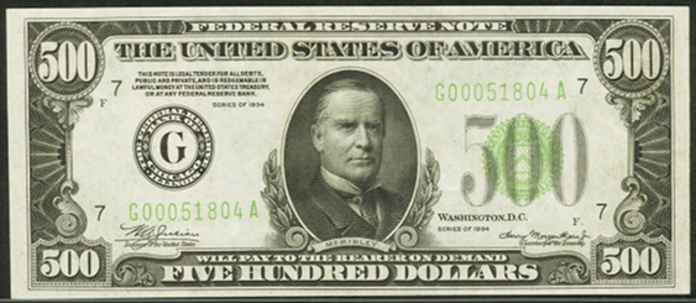 |
| The $500 bill: in circulation until 1969, but still legal tender! |
Currently, the highest denominated piece of American
currency that’s in circulation is the $100 bill. The bill has gone
through a couple of design changes in recent years, but it still has Benjamin
Franklin on the front, and Independence Hall on the back. This is as high
as American currency has gone since 1969. Before then, the United States
used to issue larger bills.
The next highest denomination was the $500 bill, which
featured President William McKinley’s portrait on the front. (No bills
over $100 had pictures on the back—just stylized printings of the denominations
written out in words, festooned with curlicues and the like, like you see
below. Older bills of this size that predate the 1930s often did have pictures on the backs.) These higher denominated bills were as follows:
$500 – Pres. William McKinley
$1000 – Pres. Grover Cleveland
$5000 – Pres. James Madison
$10,000 – Sec. of the Treasury Salmon P. Chase
$100,000 – Pres. Woodrow Wilson
These bills were more useful in the past because physical
cash transactions were a lot more common in the past than they are today.
A lot of people didn’t trust banks following the Crash of 1929, and they felt
better having something they could hold in their hands. Since the US
government recalled all gold coins in 1933, large bills were the next best
thing. Of course, people who horded cash in mattresses seldom had such
large bills. Large bills were used more for business transactions, or by
people who had a lot of money to their name to begin with. (My
grandparents, who were not rich but were spooked by the Great Depression all
the same, didn’t stash cash in a mattress, but they did so in the lining of an
old coat they kept hidden in the attic. “Stashing money in a mattress” is
an expression that’s a bit obsolete these days, and didn’t necessarily mean
your cash was actually hidden in a mattress.)
By 1969, the culture had changed to the point where
businesses mostly did high-value transactions by check rather than by cash, so
demand for larger bills had dropped off. Plus the feeling was that
organized crime had an easier time moving large amounts of money around
anonymously if they could use cash, and the government wanted to discourage
that. The last large bills over $100 were printed in 1944, so by 1969,
the supplies of these bills in good enough shape to circulate were low enough
that the government just decided to recall them all. Any bill over $100
that are deposited to a bank is turned over to the Treasury Department.
It’s not illegal to own or spend these bills, and a number of them are still in
private hands. They’re held by collectors these days, and seldom (if
ever) spent anymore.
The $100,000 bill is illegal for private citizens to own,
and always has been. These bills were only ever used for internal
business between the different Federal Reserve Banks, and even they don’t use
them anymore.
 |
| The now-obsolete $5,000 bill. |
| The $100,000 bill: legal, but not tender! |


Comments